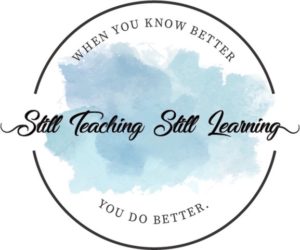
January through April is the best teaching time of the year. But sometimes it doesn’t feel like it.
After the excitement of the beginning of the year, then the fall and winter holiday breaks, we’re now in a long stretch until spring break. If you or your students are feeling a little blah, it’s time to increase engagement with some tried-and-true strategies!



Here are some of my favorite ways to engage students.
A couple of things to keep in mind . . .
1 – implementing strategies by themselves won’t matter if you haven’t built relationships with students. Get to know them. Let them know that you care about them. Work on that part first.
2 – engagement is not necessarily entertaining. Engagement means that students are mentally engaged in what they are learning and their thinking is challenged.



David Sousa wrote one of my very favorite books: How the Brain Learns.
This book is worth an entire blog post on its own, but here are a few of his tips for student engagement:
~make learning relevant & meaningful by showing how the content is used or is related to the “real world”
~break up your lessons into smaller chunks
~incorporate novelty or the unexpected
~get students up and moving with physical activity
~add music
~use humor
~let students do a lot of talking
I would also add – make positive connections with your students as much as possible.



I’m sharing some ways to use these brain-friendly tips in this post and in my next post. Make sure you subscribe so you won’t miss a thing!
MAKE POSITIVE CONNECTIONS
*Make positive connections with your students. Smile and make eye contact. Greet your students at the door in the morning or when you change classes.
Use student names when you greet them. Ask them about their interests and their family members.



*Err on the side of empathy and support, but it’s also okay to be a “warm demander.” If your student (or students) are living up to your expectations, have a private conversation with them, starting the conversation with a question such as, “Is everything okay? I’ve noticed some changes and I’m wondering how I can help you.”
*Be clear about your expectations. What do you expect students to do in order to meet the goal of the task or the behavior you expect? Show exemplars if possible.



*Move around! Notice & comment on positive work and behavior. Show your students that you see and care about what they are doing and how they are feeling.
MAKE LEARNING RELEVANT
*Make the content relevant – tell students WHY they are learning this skill or content (but don’t refer to “the test.”) Tell them HOW this skill or content will help them. Tell a story that they can relate to. Relate the lesson to a current event or to pop culture (that is appropriate for their age).
*To help your students engage with what you are teaching, model your own engagement. Show enthusiasm and tell your students why you are excited about the content. To get your students excited about reading, for instance, talk about books you love.



*Integrate student interests in your lessons where possible. Even if it’s only mentioning their name and the subject in which they’re interested, everyone will take notice that you know your students and you are focusing on them. Use their names in word problems in math. These are small actions that help make learning relevant.
*Provide choice and variety whenever possible. Even within a fairly tight schedule, you can often offer options for when to do something. Have students choose roles to play in small groups. Allow them to choose activities from a menu of options. Let them select topics for their own research, writing topics, or books to read.



BREAK LEARNING UP INTO “CHUNKS”
Here are some strategies to “chunk” your instruction.
*Set time limits for completing a task. Use any kind of timer but a timer on something like Classroom Screen is good for students as a visual.
*Chunk instruction, then allow time to process after each “chunk.” You might have students think and then write about something you just taught or you might have them talk to partners or small groups. Pro tip: make a note in your plans about where you will stop!



*Try a “brain drain” using the Kagan strategy mix-pair-share. (I love this one!)
After reading a text, or listening to a chunk of instruction, have your students walk around the classroom. (You might even play music during this part.)
When you call “pair,” students pair up with someone close by and share three things they learned. Repeat the process a couple of times.
Then have your students return to their seats and “drain their brain” by writing about what they learned. This helps them to process what they “got” from the instruction while also adding more clarification from their peers.
You might set a time limit for the brain drain so that it only takes a few minutes, then continue instruction as needed.



*Use exit tickets. These are popular for a reason. With exit tickets, students respond in writing to a question or a problem at the end of class to assess their understanding of key concepts. This should take no longer than five minutes, but it gives you a lot of information for structuring your lesson (or review or intervention) for the next day.



INCORPORATE NOVELTY OR THE UNEXPECTED
*Incorporate games and friendly competition as much as possible. Games in which students can work together are especially popular.
*When in doubt, read aloud. If you just need to change up the routine or incorporate novelty or change the energy, use a picture book (see my list HERE) or a chapter of a good read-aloud (here’s my list).
*Include art in your units where possible.



Another way to change things up is to structure your instructional blocks differently. Here are some ideas:
*Use technology for instruction. EdPuzzle is great for this (and it’s free). You could also use BrainPop videos, Nearpod, and Actively Learn.



*Change up your math block throughout the week. Use math tasks on some days, and stations or choice boards on other days.
*Start your reading block with independent reading instead of a lesson, then do the lesson after independent reading.
*Incorporate a thought-provoking statement or question at the beginning of a lesson. Or use a video that captures their interest and connects to the content you are teaching.
I hope that you found one tip that you can implement to liven up your classroom routine tomorrow! Let me know how it goes.
All of my content is intended to save teachers time and energy. Making good teaching sustainable – while also having a life outside of teaching – is my goal. Let me know how I can help you with this quick form!
Need more teacher encouragement? Join our Sustainable Teaching community!


